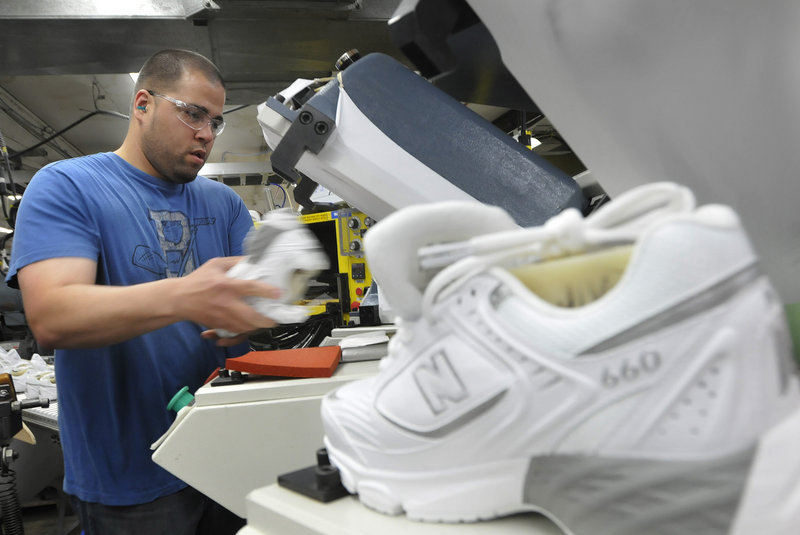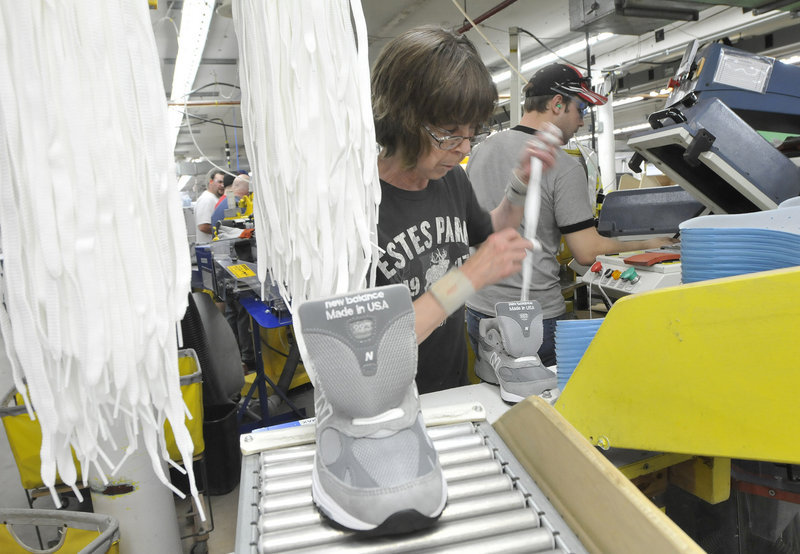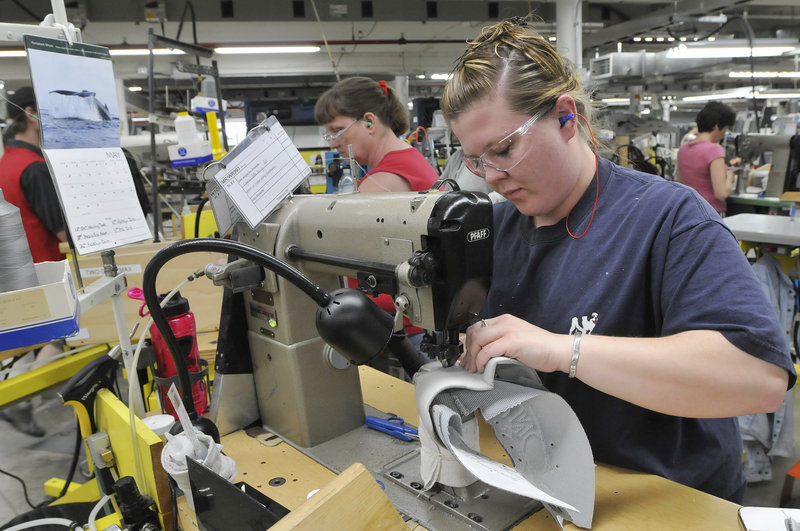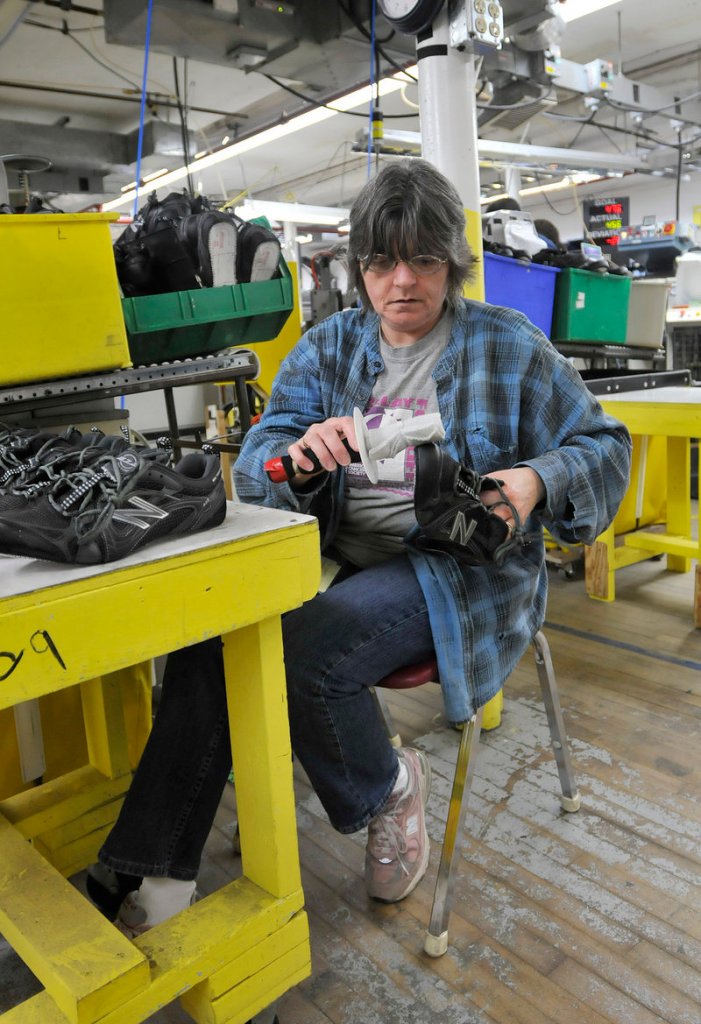NORRIDGEWOCK – Not long ago, the production process at New Balance’s Norridgewock shoe factory spanned eight days.
Today, the plant makes shoes in 70 minutes from start to finish, thanks to recently adopted production techniques pioneered by Toyota Motor Corp.
Executives say the resulting efficiency gains, as well as a direct-to-consumer sales program, have allowed the Boston-based company to keep Maine’s shoemaking heritage alive while competing with overseas producers.
“The people here and the craftsmanship represent who we are,” said Raye Wentworth, the Norridgewock plant manager. “Many (employees) come from families in the shoemaking industry.”
New Balance, a $1.78 billion athletic shoe company, operates three plants in Maine — in Norridgewock, Skowhegan and Norway — and factories in Boston and Lawrence, Mass. Those five athletic shoe plants, say executives, are the last in the United States.
New Balance has deep New England roots, being founded in Boston in the early 1900s as a manufacturer of arch supports and orthopedic shoes. In 1972, current owner James Davis purchased New Balance and began growing the company and the product line, selling athletic shoes in a vast range of sizes and widths.
Executive Vice President of Manufacturing John Wilson said soaring demand in the late 1970s and early 1980s led New Balance to open the plants in Maine, a state with a rich shoe-making history.
“We started visiting and found there were a number of shoe factories still in existence (in Maine),” said Wilson. “We were drawn there by the labor force and the skill sets.”
In 1982, New Balance began making shoes in Norridgewock and Skowhegan. The company expanded to the former Melville Shoe factory in Norway in 1997.
Today, New Balance employs more than 4,000 employees worldwide, including 838 Mainers. New Balance owns brands including Dunham, PF Flyers, Warrior and Brine.
The domestic plants manufacture 7 million pairs of shoes yearly, roughly 25 percent of the shoes the company sells in North America. New Balance also owns a plant in the United Kindom and makes shoes through partners in countries including China, Vietnam and Taiwan.
New Balance reported 2010 sales of $1.78 billion worldwide, up from $1.65 billion in 2009 and $1.64 billion in 2008, according to global public relations manager Kristen Sullivan. She attributed the growth partly to overseas sales.
Matt Powell of Charlotte-based SportsOneSource, a company that analyzes the sporting goods industry, said retail sneaker sales in the United States are roughly $20 billion annually, and are expected to grow 5 percent to 10 percent in 2011.
Powell said that in 2010 Nike and its subsidiary Jordan had roughly 45 percent market share, Skechers had 6.4 percent and New Balance had 5.8 percent.
New Balance competes with those companies, as well as Adidas, Asics, Brooks Sports, Mizuno, Reebok and Saucony, said Sullivan.
The Norridgewock plant sits near the railroad tracks and along the Kennebec River. Nearly every day, trucks arrive from Massachusetts with raw materials like mesh fabric, soles, thread and tanned pig skins.
The plant can make some 7,700 pairs of shoes daily with a staff of roughly 360.
A few years ago, Norridgewock had a “batch” production system, in which different sections of the production line worked largely independently, said Wentworth.
Fabric cutters, for instance, completed an entire batch of fabric before the batch was ready for stitching.
Production, from start to finish, took eight days and required massive amounts of inventory.
Wentworth said boxes “took up the whole building.”
In 2004, New Balance adopted what Wentworth called “single piece flow” manufacturing, one of many recent initiatives to boost efficiency.
Executives learned the process at Toyota’s Georgetown, Ky., plant.
Shoes now move down the line continuously, assembled in 44-second intervals (the goal is 38 seconds) by workers at 32 stations.
Employees first cut leather and other materials into shapes that look like jigsaw puzzle pieces.
Next, stitchers sew pieces together, and pass them, within 44 seconds, to another worker. (Materials are only passed when the next worker is ready.)
Machines then wrap the shoes over a foot-shaped mold called a last (this sets the size and fit), and workers attached the soles.
New Balance also assembles shoes at Norridgewock. These are shipped to the plant in two pieces — the sole and the upper shoe body. Workers glue them together and fit them over a last.
New Balance recently adopted a scheduling system called “kanban,” which means “sign” or “billboard” in Japanese.
Wilson said kanban matches demand, inventory and production, allowing the company to receive materials and make shoes at the same rate they are shipped.
New Balance eliminated some 35 jobs with the changes, but Wentworth said quality improved and production time dropped to 70 minutes. In addition, the plant eliminated $500,000 in inventory costs and is making shoes in less floor space.
Wilson said that although labor costs at the U.S. plants are more than 13 times higher than those in Asia, the domestic plants have an efficiency advantage.
“We are more than 13 times productive than they are,” he said.
“Single piece flow” manufacturing also lets New Balance ship shoes on the same day they are made, meaning less wait time for customers, a competitive advantage in North America.
“If you make a shoe in Asia, the lead time is at least a month. And if you air freight it, it costs seven bucks or more a pair,” he said.
Powell at SportsOneSource agreed, and added that rising fuel costs make domestic production more attractive.
In April, New Balance launched a custom-made shoe program, allowing consumers to design their own shoes online. Buyers can pick from different colors (and mix-and-match colors) and order custom embroideries.
New Balance makes and ships the custom shoes immediately so they arrive anywhere in the country in four to eight days.
“Our competitors overseas cannot do that,” said Wentworth.
Wilson called Maine’s shoemaking heritage another advantage.
“It adds a uniqueness in the market in being able to say, crafted with pride in New England or Maine,” he said.
Jonathan Hemmerdinger can be reached at 791-6316 or:
jhemmerdinger@mainetoday.com
Send questions/comments to the editors.





